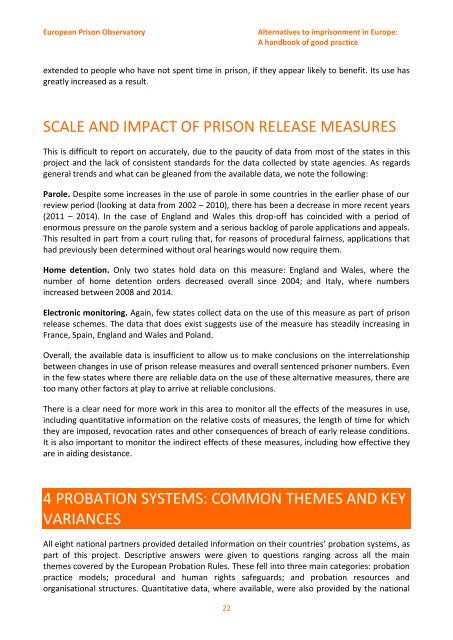good practice
Alternatives%20to%20imprisonment%20in%20Europe
Alternatives%20to%20imprisonment%20in%20Europe
You also want an ePaper? Increase the reach of your titles
YUMPU automatically turns print PDFs into web optimized ePapers that Google loves.
European Prison Observatory<br />
Alternatives to imprisonment in Europe:<br />
A handbook of <strong>good</strong> <strong>practice</strong><br />
extended to people who have not spent time in prison, if they appear likely to benefit. Its use has<br />
greatly increased as a result.<br />
SCALE AND IMPACT OF PRISON RELEASE MEASURES<br />
This is difficult to report on accurately, due to the paucity of data from most of the states in this<br />
project and the lack of consistent standards for the data collected by state agencies. As regards<br />
general trends and what can be gleaned from the available data, we note the following:<br />
Parole. Despite some increases in the use of parole in some countries in the earlier phase of our<br />
review period (looking at data from 2002 – 2010), there has been a decrease in more recent years<br />
(2011 – 2014). In the case of England and Wales this drop-off has coincided with a period of<br />
enormous pressure on the parole system and a serious backlog of parole applications and appeals.<br />
This resulted in part from a court ruling that, for reasons of procedural fairness, applications that<br />
had previously been determined without oral hearings would now require them.<br />
Home detention. Only two states hold data on this measure: England and Wales, where the<br />
number of home detention orders decreased overall since 2004; and Italy, where numbers<br />
increased between 2008 and 2014.<br />
Electronic monitoring. Again, few states collect data on the use of this measure as part of prison<br />
release schemes. The data that does exist suggests use of the measure has steadily increasing in<br />
France, Spain, England and Wales and Poland.<br />
Overall, the available data is insufficient to allow us to make conclusions on the interrelationship<br />
between changes in use of prison release measures and overall sentenced prisoner numbers. Even<br />
in the few states where there are reliable data on the use of these alternative measures, there are<br />
too many other factors at play to arrive at reliable conclusions.<br />
There is a clear need for more work in this area to monitor all the effects of the measures in use,<br />
including quantitative information on the relative costs of measures, the length of time for which<br />
they are imposed, revocation rates and other consequences of breach of early release conditions.<br />
It is also important to monitor the indirect effects of these measures, including how effective they<br />
are in aiding desistance.<br />
4 PROBATION SYSTEMS: COMMON THEMES AND KEY<br />
VARIANCES<br />
All eight national partners provided detailed information on their countries’ probation systems, as<br />
part of this project. Descriptive answers were given to questions ranging across all the main<br />
themes covered by the European Probation Rules. These fell into three main categories: probation<br />
<strong>practice</strong> models; procedural and human rights safeguards; and probation resources and<br />
organisational structures. Quantitative data, where available, were also provided by the national<br />
22





